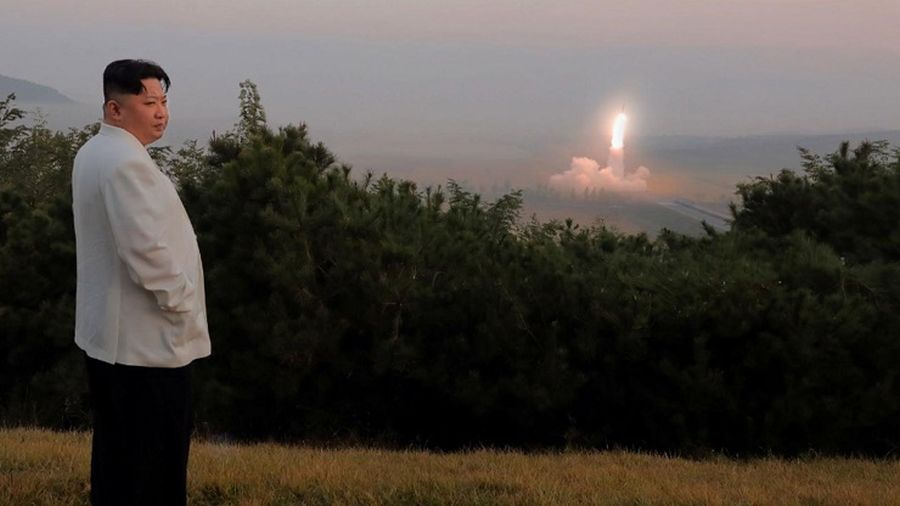DPRK Launches Medium-Range Missile, Danger Line Is One Step Closer
The current rise in tensions on the Korean peninsula is by no means over with US carrier group maneuvers and a series of short-range North Korean missile launches.
It should be recalled that “in a previous episode” the US and ROK conducted naval exercises involving the aircraft carrier USS Ronald Reagan and, more importantly, resumed meetings of the Extended Deterrence Strategy and Consultation Group (EDSCG), which has the potential of placing new US “strategic assets” in the ROK. The DPRK responded with four short-range missile launches during the week.
On October 1, 2022, during Armed Forces Day celebrations, South Korea released a video of an advanced ballistic missile that is part of the so-called Korean Massive Punishment and Retaliation system (KMPR). It is a plan to eliminate North Korea’s leadership and disable key infrastructure in the event of a major conflict.
From October 4 to 12, 2022, a multinational naval mine warfare exercise began in waters off Pohang, involving naval forces from 10 countries, including the United States and the United Kingdom. Officially, the exercise is designed to strengthen cooperation between participating countries and help member states of the US-led United Nations Command (UNC) become familiar with the combat conditions on the Korean peninsula. Unofficially, if gossip is to be believed, mines are being laid to organize a naval blockade of the DPRK as part of the next sanctions package following the alleged nuclear test.
As a counterbalance, on October 4, 2022, North Korea launched a medium-range ballistic missile (presumably the Hwasong-12) over Japan; unlike the previous MRBM launch in January, it was not an altitude trajectory.
Unsurprisingly, the flight over Japan caused alarm in Tokyo, with authorities ordering the evacuation of Hokkaido and Aomori Prefecture, the northernmost tip of Honshu Island. The last time North Korean missiles flew over Japanese territory was in 2017, when the DPRK launched the Hwasong-15 and Hwasong-17 intercontinental ballistic missiles several times.
Meanwhile, at the Punggye-ri nuclear test site, activity near tunnel No. 4 has increased – the area at the entrance to the tunnel has been cleared, construction of the access road has resumed and support buildings and facilities are under construction. Although, tired of the North never blowing up anything on the “agreed upon” dates, Western experts and South Korean intelligence say the long-awaited test will happen after October 16, when the CPC Congress in China begins and takes place.
In addition, according to the ROK Ministry and Defense, North Korea is preparing to test new liquid-propellant intercontinental ballistic missiles (ICBMs) and submarine-launched ballistic missiles (SLBMs).
North Korea’s power demonstration elicited a similar response, although it was not without curious incidents. The US and Japanese forces conducted a joint exercise in the skies over Japan’s Kyushu Prefecture, involving the Japan Air Self-Defense Force’s 5th and 8th Air Wings and 12 F-35Bs of the US Marine Corps. In addition, South Korea and the US launched four surface-to-surface missiles (ATACMS) towards the Sea of Japan. A Hyunmoo-2 missile was about to be launched, but a technical malfunction caused it to crash into a fuel tank at the 18th Fighter Aviation Regiment airbase. This triggered a fire and several other explosions. Fortunately, the warhead didn’t explode and no one was hurt.
Finally, it has been reported that an aircraft carrier strike group led by the nuclear-powered aircraft carrier Ronald Reagan, set off on September 30 after a joint Japanese, US and South Korean naval exercise, is returning to the waters of the Sea of Japan. The corresponding decision was made following consultations between the US and Korean defense ministers to demonstrate the allies’ “firm will to counter this kind of provocation by Pyongyang.” Interestingly, according to Reuters, the Pentagon declined to comment on the aircraft carrier redeployment.
On October 5, the DPRK Foreign Ministry issued a statement saying that Pyongyang was closely monitoring the return of the aircraft carrier Ronald Reagan to the shores of the Korean peninsula, which would destabilize the political situation in the region.
On the same day, October 5, at the UN Security Council, US Ambassador Linda Thomas-Greenfield criticized Russia and China, which regularly oppose the renewal of the sanctions regime. The passive response of the Security Council is encouraging further provocations by North Korea, she said. A draft official press statement condemning Pyongyang’s actions was presented during the meeting. The representatives of the ROK and Japan supported the draft statement, agreeing on the need for action at the UN Security Council level.
However, China and Russia opposed the official statement and additional sanctions and spoke up for the DPRK. Anna Evstigneeva, Russia’s Deputy Permanent Representative to the UN, pointed out that North Korea was prompted to act by the irresponsibility of US-led joint exercises, while her Chinese counterpart Geng Shuang described the problem as a confrontation between the US and North Korea and called for a more conciliatory approach from Washington.
As a result, the US on one side, the PRC and Russia on the other accused each other of provoking North Korea. The US side said Beijing and Moscow’s refusal to cooperate gave the DPRK courage. The Chinese and Russian representatives, for their part, pointed out that the provocations by the North were a response to the US policy.
As a result, no Council-level condemnation statement was adopted in closed session, although eleven countries (the US, South Korea, Japan, Albania, Brazil, India, France, Ireland, Norway, the UAE and the UK) issued a statement condemning Pyongyang’s actions, “which are in violation of multiple UNSC resolutions and pose threat to the region and the international community.” The statement calls on all participating countries to comply with their sanctions obligations under existing UNSC resolutions.
The DPRK, however, was unhappy with the very fact of the debate and on October 6 its Foreign Ministry strongly condemned “the United States and a number of its satellite states for unjustly raising the issue of the justified response of our army to the US-South Korean joint exercise exacerbating military tensions on the Korean peninsula in the UN Security Council.” It was noted that the return of the aircraft carrier group “poses a serious threat to the stability of the situation on and around the Korean Peninsula.”
On the morning of October 6, 2022, the DPRK launched two short-range ballistic missiles towards the Sea of Japan.
A little later on October 6, four North Korean bombers and eight fighter jets flew in tight formation, similar to the power demonstrations by ROK aviation in the summer. North Korean Air Force exercises are rarer than missile launches, and in response the South immediately put some 30 F-15K fighter jets into the air. However, said exercise is not a violation of the inter-Korean military agreement, which was signed in Pyongyang on September 19, 2018.
On October 7, another US-South Korean naval exercise involving the aircraft carrier group Ronald Reagan and Co. began in international waters east of the Korean peninsula. On the same day, October 7, ROK President Yoon Suk-yeol announced gradual preparation for a response to North Korea’s seventh nuclear test, the details of which have not yet been disclosed.
It is very likely that the escalation will not end there, and although the intensity of the power demonstration is higher than a year ago, the author does not yet see a serious threat to security. Another thing is that any aggravation of this kind does not help to reduce regional tensions and inter-Korean relations will remain in a state of cooling.
The second point the author wants to emphasize is the demonstration of the North’s capabilities. The launches are no longer covered by North Korean media, having become an everyday occurrence. Since the beginning of 2022, the country has conducted more than 20 missile tests, firing nearly 50 ballistic missiles, the highest number of missiles launched in a year. Four launches in a week is also a kind of record.
Russian military expert Vladimir Khrustalev writes on this subject: “The intensity and variety of the launches unequivocally proves one thing. The DPRK is not just “another missile-making country.” It is a big missile power with a quite large series of test, demonstration and training launches. And it is clear that these launches are backed by a well-developed serial production of these very missiles. All in all, the great program of reconstruction of the defense industry and science implemented in the 2010s has been a success.”







